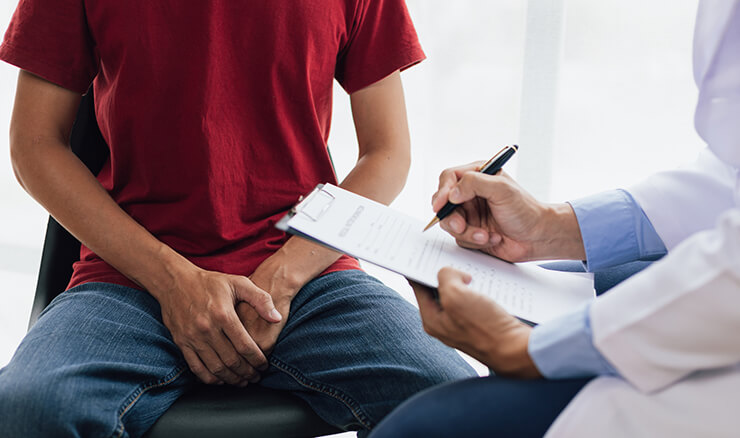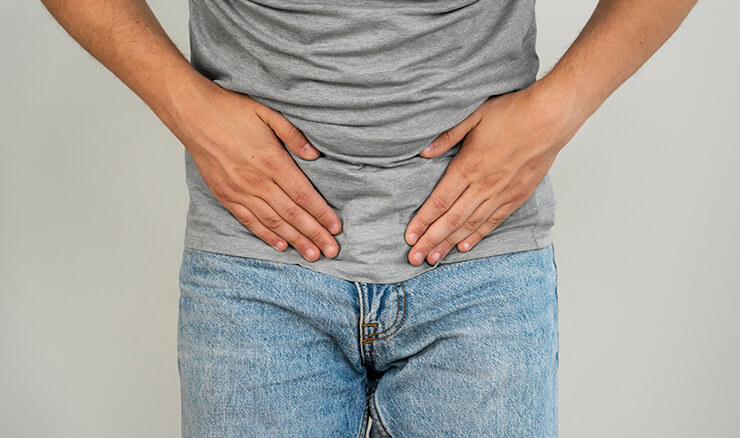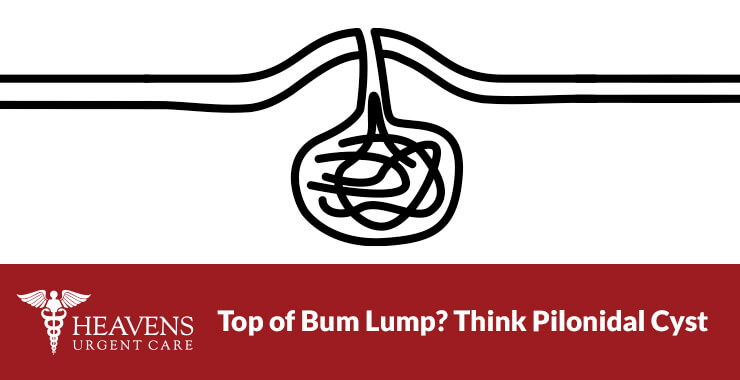Most people think of urinary tract infections as a women’s health issue, but the truth is that men can, and do, get urinary tract infections. While less common in men than in women, urinary tract infections can still cause painful symptoms, disrupt daily life, and sometimes lead to serious complications if left untreated.
The good news is that with the right care this troublesome infection is very treatable. Understanding the how, why, symptoms, and when to use over-the-counter meds for a UTI is the key to fast relief. So, let’s begin with some quick facts that are specific to men and urinary tract infections.
The Facts about UTIs in Men
Up to 20% of males will have a UTI in their lifetime. And although this statistic is low, it’s important to know that symptoms include burning with urination, frequent urges to urinate, cloudy or bloody urine, and pelvic or back pain.
Risk factors for men include an enlarged prostate, kidney stones, diabetes, and being uncircumcised.
Over-the-counter options can help manage pain and discomfort, but antibiotics are most often necessary.
TIP: See a doctor if symptoms last more than a day, if you have fever or back pain, or if you’re over age 50.
What Exactly Is a UTI?
A urinary tract infection occurs when bacteria called Escherichia coli (E. coli) from the digestive tract enters the urinary system and begins to multiply. This can affect three areas. The urethra (urethritis), the bladder (cystitis), and the kidneys (pyelonephritis, which is more serious).
While women are more prone to a UTI because they have a shorter urethra, men are not immune. Research from the National Institute of Diabetes and Digestive and Kidney Diseases shows that men, particularly as they age, face increased risk due to prostate enlargement and other health issues.
UTIs don’t always look the same, but common symptoms in men include:
- Burning or stinging sensation during urination
- Frequent urge to urinate, even with little output
- Cloudy, foul-smelling, or bloody urine•Pelvic pain or discomfort in the lower abdomen
- Pain in the back or side (may indicate kidney involvement)
- Low-grade fever or chills (a sign the infection is spreading)
- Difficulty starting urination or weak urine stream (often linked to prostate enlargement)
If you’re experiencing any of these symptoms, don’t ignore them. Untreated UTIs can spread to the kidneys and bloodstream, which may become dangerous.

Why Men Get UTIs
A urinary tract infection in men can occur for several reasons:
Anatomy: Men have a longer urethra, which normally helps protect them, but bacteria can still travel up the urinary tract.
Enlarged Prostate (BPH): As men age, the prostate often enlarges. This can obstruct urine flow, leaving bacteria behind to multiply. According to the American Urological Association, BPH is one of the most common contributors to urinary symptoms in men over 50.
Kidney Stones: Stones can block urine flow and increase infection risk.
Intimacy: Sexual contact can introduce bacteria into the urinary tract, especially in uncircumcised men.
Medical Conditions: Diabetes, immune suppression, or prior urinary tract surgeries increase the likelihood of infection.
Catheter Use: Any device in the urinary tract raises infection risk.
INTERESTING RESEARCH: A 2021 review in Clinical Microbiology and Infection found that UTIs in men are increasingly resistant to common antibiotics, making medical supervision especially important.
Over-the-Counter Treatments for Men with UTIs
While antibiotics are the main treatment for bacterial UTIs, some over-the-counter options can provide symptom relief until you see a healthcare provider:
- Phenazopyridine (AZO, Uristat): Helps numb urinary pain and burning (note: this does not cure the infection).
- Acetaminophen or Ibuprofen: Reduces fever, discomfort, and inflammation.
- Cranberry supplements: Some evidence suggests cranberry may help reduce recurrence, though results are mixed (NIH review).
- Hydration: Drinking extra water helps flush bacteria out.
- Probiotics: Support gut and urinary health, though more research is needed.
IMPORTANT NOTE: These remedies help with comfort, but they do not eliminate the infection itself. Men usually require antibiotics prescribed by a doctor.
Men should see a doctor for a UTI if symptoms last more than 24–48 hours and are accompanied by a fever, chills, or back pain. Don’t wait if the urine is bloody or cloudy for more than a day and if nausea or vomiting is present.
Additionally, it’s important to see a doctor if you’re over 50 and have prostate symptoms or have diabetes or a weakened immune system. A doctor will generally run a urine culture to identify the bacteria and prescribe the right antibiotic. In some cases, further tests like an ultrasound or cystoscopy may be recommended.

5 Ways Men Can Prevent a UTI
- Stay hydrated
- Urinate after sexual activity
- Manage blood sugar if diabetic
- Avoid holding urine for long periods
- Keep the genital area clean
At Heavens Urgent Care, we know that men sometimes delay seeking care for issues like urinary discomfort. But UTIs don’t just go away on their own. Whether you’re in Apache Junction, San Tan Valley, Gold Canyon, or Queen Creek, our experienced providers are here to help, in person or through a secure online video visit.
We can:
- Perform urine tests quickly
- Prescribe the right antibiotics
- Provide symptom relief recommendations
- Rule out other causes like kidney stones or prostate problems
So, can men get urinary tract infections? The answer is always yes and while less common than in women, UTIs in men can be more complicated and require prompt treatment.
If you suspect you have a UTI, don’t ignore the signs. Over-the-counter remedies may ease discomfort, but antibiotics are usually needed to cure the infection and prevent serious complications.
Your health matters, so don’t wait. Book your appointment today by calling 480-444-1160 and let our friendly medical team help you feel better, faster.







